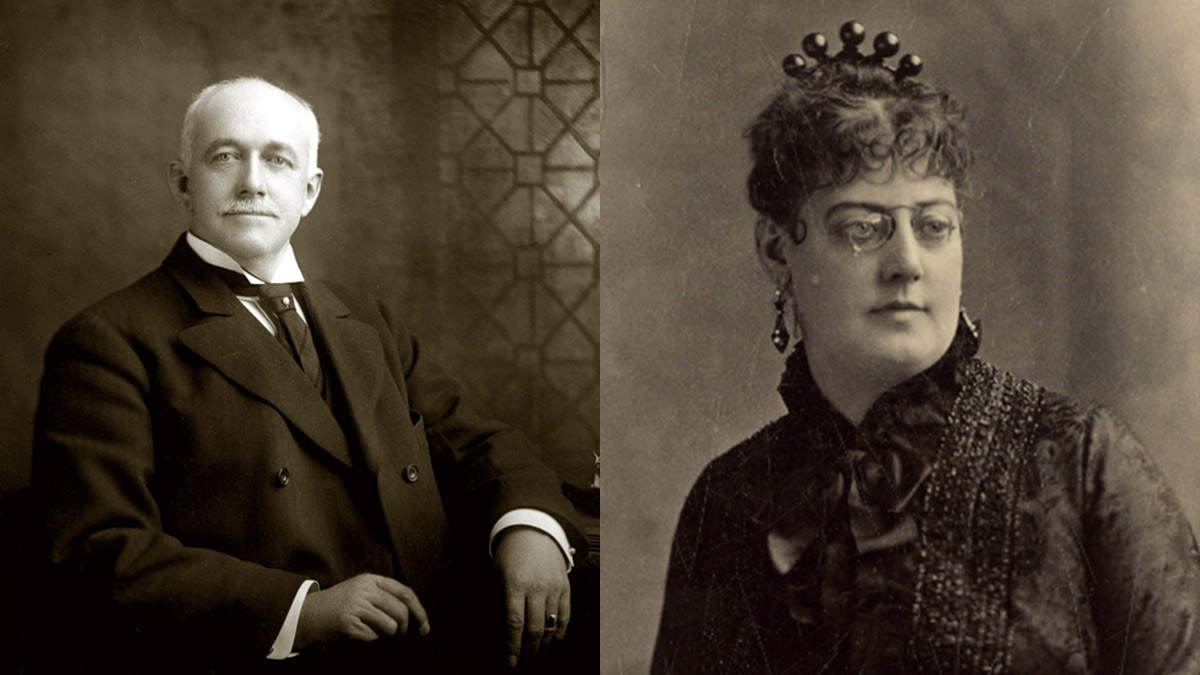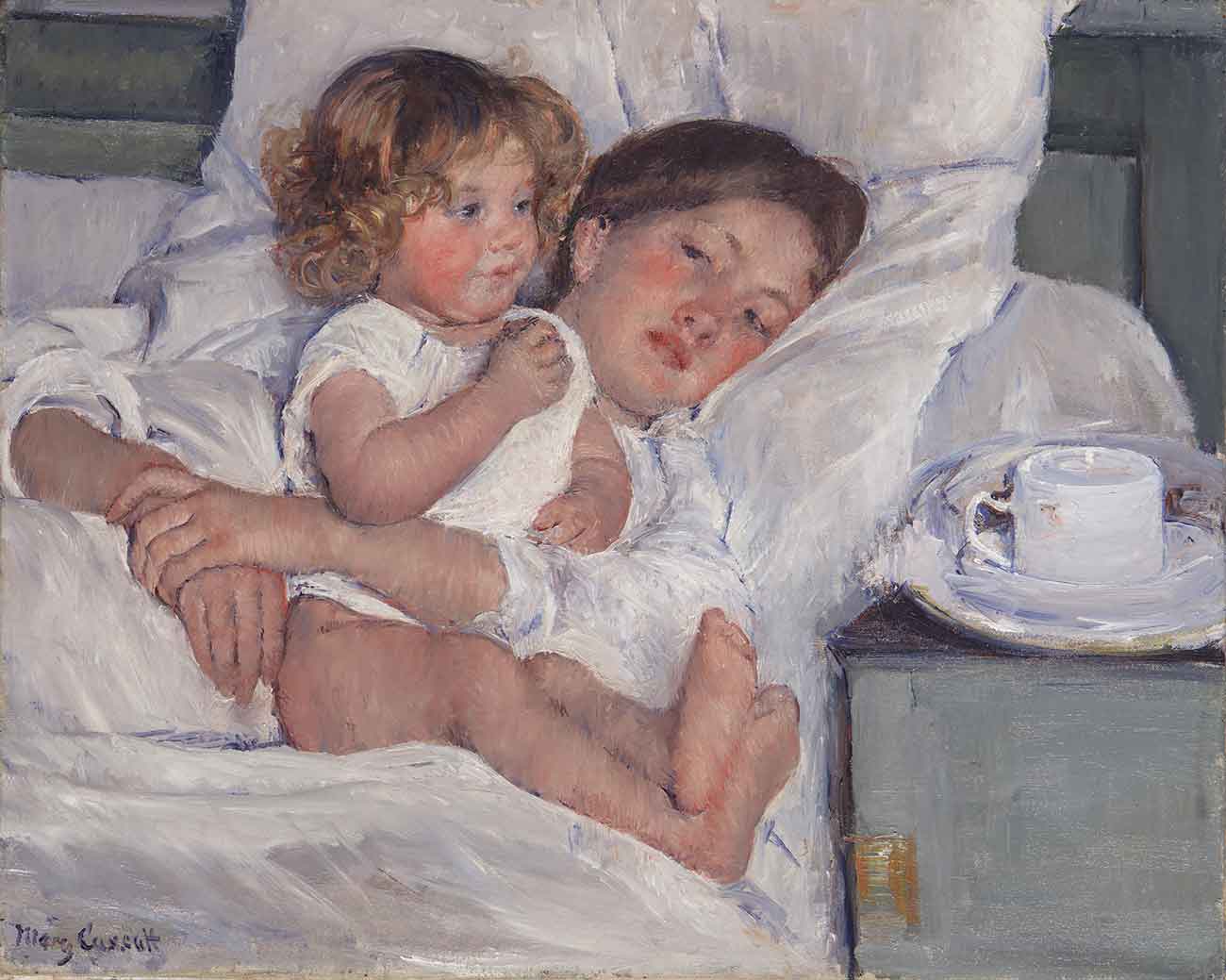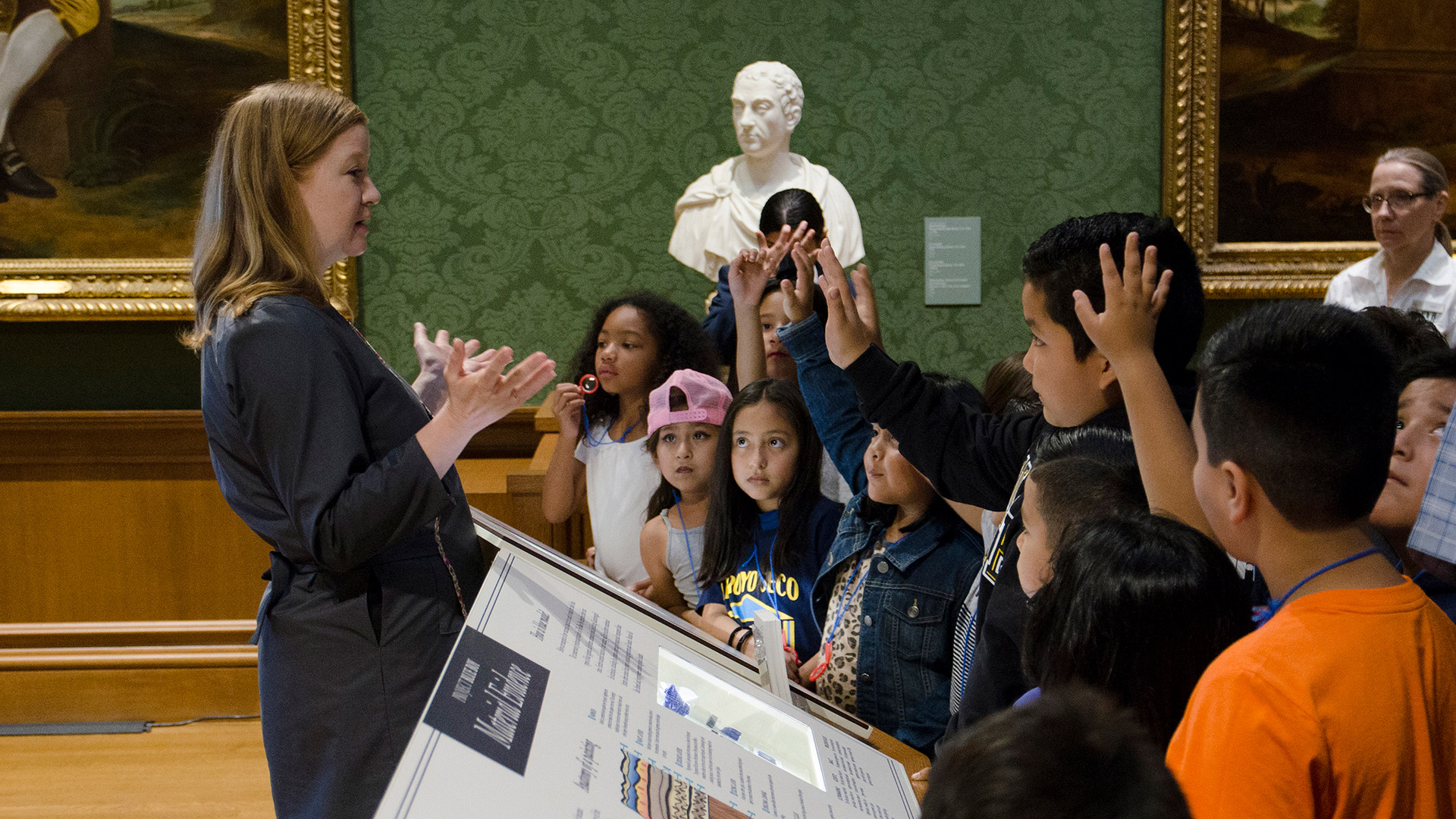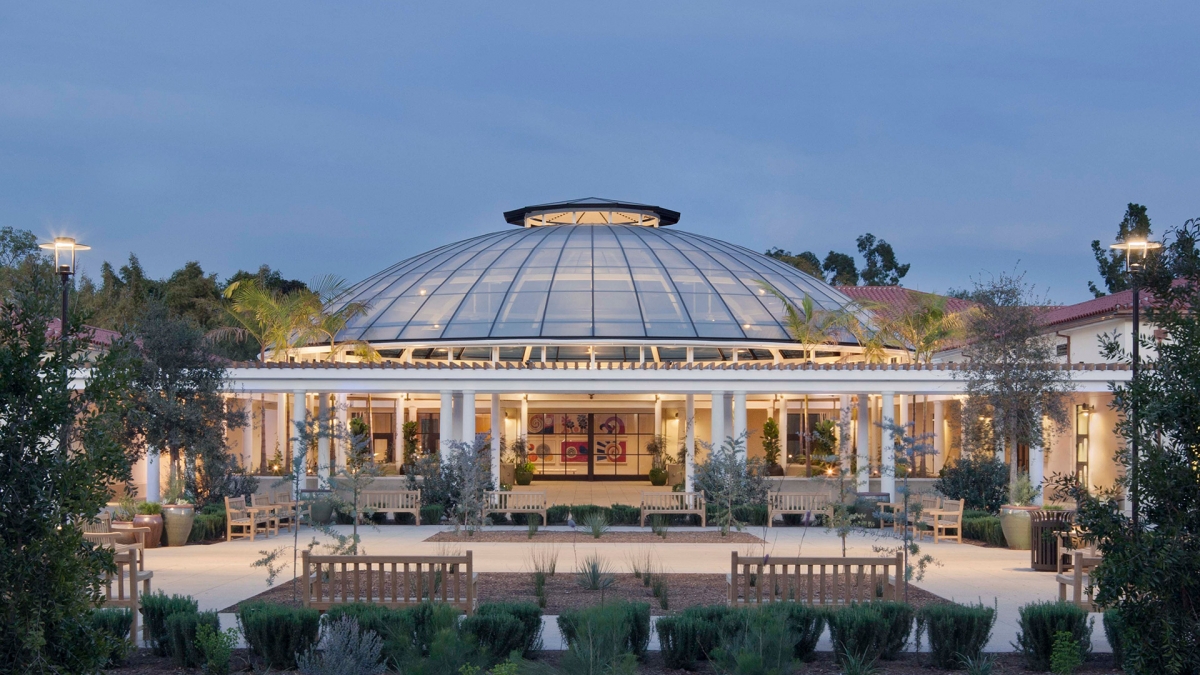
Our Organization
Henry E. and Arabella Huntington

Railroad and real estate businessman Henry Edwards Huntington was born on Feb. 27, 1850, in Oneonta, New York. Henry and his uncle, Collis P. Huntington, were leaders in building the railroads that span the country. In 1892, Henry moved to San Francisco to represent Huntington interests on the Pacific Coast. In 1902, two years after the death of Collis, Henry transferred his headquarters to Los Angeles and started to connect, consolidate, and extend the electric railway system in Southern California (the “Red Cars”). He had large landholdings in Southern California and numerous business interests. In 1903, he bought the San Marino Ranch (now The Huntington). He married Arabella Duval Huntington, the widow of Collis, in 1913. Together they amassed extensive library, art, and botanical collections that continue to evolve. In August 1919, they signed a trust document that transformed their private estate into a public institution, making their collections available “to promote the public welfare.” Henry died in 1927; Arabella predeceased him by three years. The Huntington opened publicly to visitors in 1928 and has grown over the past century to become an internationally renowned collections-based nonprofit institution that supports and promotes the humanities, the arts, and botanical science. The Huntington aspires to be a welcoming place for all and is committed to fully embracing diversity among staff, visitors, curators, and scholars, and to preserving, building, and sharing its collections with a diverse and global community.
Library
The Huntington Library is one of the world’s great independent research libraries, with some 12 million items spanning the 11th to the 21st century. These extraordinary and diverse materials are centered on 14 intersecting collection strengths: American history; architecture; British history; early printed books; Hispanic history and culture; history of science, medicine, and technology; literature in English; maps and atlases; medieval manuscripts; prints, posters, and ephemera; photography; Pacific Rim history and culture; California history and culture; and history of the American West.
Its collections encompass:
- 8.9 million manuscripts
- 435,000 rare books
- 450,000+ reference books
- 914,000 prints and ephemera
- 800,000 photographs
- 512,000 digital files

LIBRARY HIGHLIGHTS
- One of the world’s largest collections of British medieval manuscripts, including the 15th-century Ellesmere manuscript of Geoffrey Chaucer’s The Canterbury Tales.
- One of 12 surviving copies on vellum of the Gutenberg Bible, the jewel of the second-largest collection of incunabula (15th-century printed books) in the United States.
- A leading repository for Americana, including extensive holdings for Lincoln, Washington, and Jefferson, and such gems as the original manuscript of Franklin’s autobiography.
- Extensive collections on the American West, including the great 19th-century photographic surveys and original sources about overland migration, industry and transport, and Native Americans.
- Premier California archival collections on topics ranging from agriculture and urban infrastructure to legal and political history, and Chinese immigration.
- Formidable strengths in English-language literature with manuscripts and early editions by such authors as William Blake, Jack London, and Henry David Thoreau, and literary archives of Charles Bukowski, Octavia E. Butler, and Hilary Mantel, among others.
- Science, medicine, and technology holdings ranging from a 13th-century Ptolemy Almagest manuscript and landmark printed books in the renowned Burndy Library to modern aerospace archives.
- Extensive holdings of prints, posters, and ephemera, including the Jay T. Last Collection of Graphic Arts and Social History.
Researchers from 27 countries made 14,000 visits to the Library to study rare collections in the reading rooms. Library staff assists an additional 4,300 researchers from all over the world through remote reference services and 240 Virtual Reading Room appointments.
Digitized collections in the Huntington Digital Library receive 3 million page views per year.
A team of professional book, paper, and painting conservators carry out thousands of hours of collections treatment and care annually for Library and Art collections.
Three Library exhibition halls, with a combined 9,000 square feet of dedicated space, showcase some of the most outstanding materials in the collection. The Main Hall features 150 rare items grouped thematically around 12 iconic works, including the Gutenberg Bible and Thoreau’s Walden manuscripts.
The 90,000-square-foot Munger Research Center provides workspace for scholars and staff, facilities for conservation and digital imaging, as well as collections storage.
Art Museum
The Art Museum features European and American art spanning more than 500 years and includes more than 44,000 objects. Extraordinary examples of decorative arts and folk art, paintings, prints and drawings, photography, and sculpture are displayed in the Huntington Art Gallery, the original home of Henry and Arabella Huntington, and in the Virginia Steele Scott Galleries of American Art. Both buildings also showcase smaller, temporary exhibitions that focus on masterworks in the collection or place The Huntington’s historic works in conversation with contemporary artistic practice.
EUROPEAN ART HIGHLIGHTS
- One of the greatest collections of 18th-century British grand manner portraiture outside of the United Kingdom, including Thomas Gainsborough’s The Blue Boy and Joshua Reynolds’ Sarah Siddons as the Tragic Muse, as well as important examples of 19th-century British landscape painting by such artists as John Constable and J. M. W. Turner; major holdings of materials related to the Arts and Crafts movement, including works by Edward Burne-Jones and Walter Crane, with particular strength in designs produced by the William Morris firm; more than 19,000 British drawings, ranging from the 17th to the 21st century, including William Blake’s watercolor designs for illustrations to John Milton’s Paradise Lost, fine examples by artists associated with the Pre-Raphaelite Brotherhood, and such modernists as David Bomberg and Paul Nash.
- Important holdings of 18th-century decorative art, particularly French furnishings and textiles produced before the French Revolution, including The Noble Pastoral, a series of tapestries made by the Beauvais manufactory, and a significant group of Sèvres porcelain garnitures; 18th-century French sculpture, including the life-size bronze Diana the Huntress by Jean-Antoine Houdon, and such paintings as Young Knitter Asleep by Jean-Baptiste Greuze and the Portrait of Rabaut Saint-Etienne by Jacques-Louis David.
AMERICAN ART HIGHLIGHTS
- Begun with a major gift from the Virginia Steele Scott Foundation in 1979, the American art holdings number about 365 paintings, 101 works of sculpture, 1,452 decorative art objects, 2,554 prints and 7,665 drawings, and 1,937 photographs.
- Masterpieces in the paintings collection include Frederic Edwin Church’s monumental Chimborazo; Mary Cassatt’s intimate Breakfast in Bed; Edward Hopper’s evocative sailing scene, The Long Leg; Andy Warhol’s Small Crushed Campbell’s Soup Can (Beef Noodle); and Charles White’s Soldier, an important example of 20th-century social realism.
- The Jonathan and Karin Fielding Collection contains 18th- and 19th-century paintings, furniture, and works of decorative art, offering visitors insights into the history of American art practices through beautiful objects made for everyday living by early Americans.
- An important part of the permanent installation is a gallery devoted to the work of early 20th-century Pasadena architects and Arts and Crafts masters Charles and Henry Greene.

Mary Cassatt (1844-1926), Breakfast in Bed, 1897. The Huntington Library, Art Museum, and Botanical Gardens. Gift of the Virginia Steele Scott Foundation.
Botanical Gardens
Encompassing approximately 130 acres of the 207-acre grounds, the Botanical Gardens contain more than a dozen spectacular themed gardens.
GARDEN HIGHLIGHTS
- Liu Fang Yuan 流芳園, the Garden of Flowing Fragrance, reflects the traditional style of scholar gardens in Suzhou, China, and features a 1.5-acre lake, a complex of pavilions, a teahouse and tea shop, stone bridges, and waterfalls set against a wooded backdrop of mature oaks and pines. The garden’s final phase includes new pavilions, a restaurant, and an exhibition complex. At more than 15 acres, the garden is one of the largest classical-style Chinese gardens in the world.
- The Japanese Garden, set along a canyon to the south of the Chinese Garden, comprises a traditional Japanese house, a moon bridge, a walled Zen garden, bonsai courts, and Seifu-an, a ceremonial teahouse and garden. The Japanese Heritage Shōya House is a restored residential compound from 18th-century Japan that provides a glimpse into rural Japanese life some 300 years ago.
- The Desert Garden features one of the largest outdoor collections of mature cacti and succulents in the world.
- The Frances and Sidney Brody California Garden in the Steven S. Koblik Education and Visitor Center is arranged along a central allée of olive trees. The garden includes native and adaptive plantings set among hedge rooms in a nod toward more formal landscape design.
- The Frances Lasker Brody Botanical Center features:
- The Helen and Peter Bing Children’s Garden, introducing youngsters to the wonders of the natural world through interactive sculptural elements.
- The Rose Hills Foundation Conservatory for Botanical Science and the Associated Foundations Teaching Greenhouse, providing hands-on botanical science opportunities for children and families, and showcasing orchids and other tropical collections.
- Laboratories for research where botanists are using cryopreservation techniques to safely freeze and conserve fragile plant tissue, and where genetic research reveals much about the evolutionary history of cycads.
- The Ranch Garden, for testing and demonstrating contemporary ideas about sustainable urban agriculture.
- Collections include more than 84,000 accessioned living plants.
- Additional garden areas devoted to roses and camellias, each collection with more than 1,000 different cultivars.
- The Australian, Herb, Jungle, Lily Ponds, Palm, and Subtropical gardens are among other important botanical attractions.

Research
Each year, some 2,000 scholars in the fields of history, literature, art history, and the history of science, technology, and medicine come from around the world to conduct academic research in The Huntington’s Library and Art collections. About 150 of these faculty and graduate students receive research grants or fellowships, which are awarded through a rigorous process of external peer review. The scholarship that is carried out in the reading rooms results in academic monographs and scholarly articles, in bestselling and prizewinning books, in acclaimed documentary films, and in many of the history and social studies texts used to educate the nation’s schoolchildren. The Huntington also disseminates research through an extensive program of academic conferences, workshops, seminars, and lectures.
In partnerships with USC and Caltech, The Huntington has established three research centers: The USC-Huntington Early Modern Studies Institute supports advanced research and scholarship on human societies between 1450 and 1800; the Huntington-USC Institute on California and the West brings together historians, journalists, and policymakers to investigate the history of the American West; and the Research Institute for the History of Science and Technology at Caltech and The Huntington facilitates the exploration of the history of science and technology. The Huntington also participates with other neighboring institutions through several humanities collaborations with Caltech and through The Huntington-University of California Program for the Advancement of the Humanities.

Education
The Huntington’s education programs interpret the collections and promote lifelong learning to a broad audience.
- Each year, more than 15,000 students participate in school-based programs on campus.
- The Huntington partners with schools and school districts to provide deep, long-term engagement with students and teachers through school visits and professional development for teachers. Education staff uses inquiry-based techniques and then helps educators implement these techniques into their own teaching.
- Nearly 80,000 individuals participate each year in educational public programs, including classes, workshops, and our summer program for children, Huntington Explorers. More than 50,000 guests explore the Mapel Orientation Gallery as part of their visit.
- The Huntington collaborates regularly with the Boys and Girls Club, YWCA, and other community organizations serving young people and diverse audiences.

Architecture at a Glance
The Huntington is known for its architecture.
- The Huntington Art Gallery, originally Henry and Arabella’s home, was designed by Myron Hunt and Elmer Grey. It was constructed from 1909 to 1911 and comprises 55,000 square feet. A 2008 renovation and adaptive reuse was led by Earl Corp. and Architectural Resources Group.
- The Virginia Steele Scott Galleries of American Art comprises the Virginia Steele Scott Gallery (1984), designed by Paul Gray, and the Lois and Robert F. Erburu Gallery (2005), designed by Frederick Fisher, a space totaling 39,100 square feet. A new addition, also designed by Fisher, the Jonathan and Karin Fielding Wing, opened in 2016, adding 8,600 square feet.
- The MaryLou and George Boone Gallery was designed by Hunt and Grey as the Huntingtons’ garage and built in 1911. The 8,000-square-foot structure was converted to gallery space in 1999 by architect Brenda Levin.
- The original 96,000-square-foot Library building was designed by Hunt and Grey and built in 1919; it has five subsequent additions, including the 90,000-square-foot Munger Research Center (2004), designed by Earl Corp.
- The Huntington Mausoleum is the burial place of Henry and Arabella. It was designed by John Russell Pope (responsible for the Jefferson Memorial in Washington, D.C.), with sculpture by John Gregory, and completed in 1929.
- The Frances Lasker Brody Botanical Center was designed by Offenhauser and Associates and includes a maintenance complex (15,000 square feet; built in 2000); the research and education facility (45,000 square feet; 2001); The Rose Hills Foundation Conservatory for Botanical Science (18,000 square feet; 2003), and the Helen and Peter Bing Children’s Garden (43,500 square feet; 2004).
- The Steven S. Koblik Education and Visitor Center (2015) comprises 94,000 square feet of interior space. The complex encompasses 52,000 square feet of classrooms, an auditorium, a multipurpose room, cafe, coffee shop, gift shop, boardroom, and orientation gallery. It also includes 42,000 square feet of underground storage space. The complex was designed by Architectural Resources Group; the landscape architect was the Office of Cheryl Barton.
